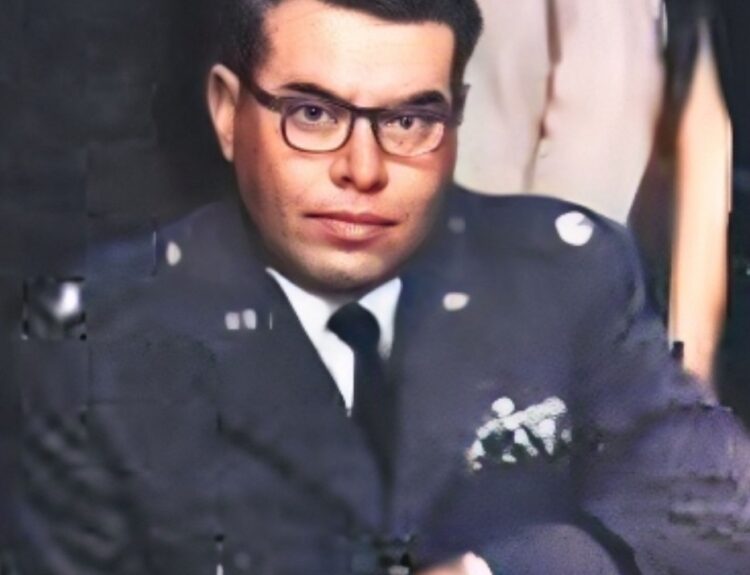When it comes to the study of unidentified flying objects (UFOs) and unidentified aerial phenomena (UAPs), one name stands out in the annals of history: Captain Edward J. Ruppelt. Often considered a pioneer in the field of UFO research, Ruppelt’s contributions were pivotal during the early years of the U.S. Air Force’s official investigations into these phenomena. His work not only shaped the direction of government inquiry into the UFO phenomenon but also laid the groundwork for the serious and scientific approach to UFO investigations that persists today.
The Early Years: A Foundation in Aviation
Edward James Ruppelt was born on July 17, 1923, in Iowa. From a young age, he displayed an aptitude for mechanics and aviation, interests that would later define his career. During World War II, Ruppelt served as a bombardier in the U.S. Army Air Forces, flying combat missions over Europe. His bravery and skill earned him multiple commendations, including five battle stars, three Air Medals, and two Distinguished Flying Crosses.
After the war, Ruppelt continued his military career, transitioning to the newly formed U.S. Air Force. He furthered his education in aeronautical engineering, a discipline that would serve him well in his future role as the head of Project Blue Book. His technical expertise, combined with his experience as a combat veteran, made him an ideal candidate for handling the complex and often controversial subject of UFOs.
Project Blue Book: Bringing Order to the Chaos
In the years following World War II, reports of UFO sightings surged, capturing the attention of both the public and the military. The U.S. Air Force had already launched several initiatives to investigate these sightings, including Projects Sign and Grudge, but these efforts were plagued by inconsistency, lack of scientific rigor, and internal disagreements. By 1951, it became clear that a more structured and professional approach was needed.
Enter Captain Edward J. Ruppelt. In 1951, Ruppelt was appointed to lead Project Blue Book, the Air Force’s newly centralized effort to investigate UFO reports. From the outset, Ruppelt sought to transform the program into a serious scientific inquiry, free from the sensationalism that often surrounded UFO phenomena. He brought a level-headed and methodical approach to the project, insisting that all reports be evaluated based on evidence and scientific principles.
One of Ruppelt’s first actions was to standardize the terminology used in UFO investigations. He coined the term “unidentified flying object” (UFO), replacing the previously used “flying saucer,” which had become synonymous with alien spacecraft in the public imagination. By introducing the term UFO, Ruppelt aimed to create a neutral, scientifically sound language that would help to depersonalize and legitimize the study of these phenomena.
The Height of UFO Investigations: A Systematic Approach
Under Ruppelt’s leadership, Project Blue Book became the most thorough and organized investigation of UFOs undertaken by the U.S. government. During his tenure, the project investigated over 4,000 UFO reports, many of which remain unexplained to this day. Ruppelt’s approach to these investigations was characterized by a rigorous methodology. He established a system for categorizing UFO sightings, distinguishing between those that could be explained by conventional means (such as aircraft, weather balloons, or atmospheric phenomena) and those that remained unidentified.
One of the key aspects of Ruppelt’s approach was his emphasis on gathering as much information as possible before drawing any conclusions. He encouraged witnesses to provide detailed accounts of their sightings and sought out corroborative evidence, such as radar data, photographs, and physical traces. This meticulous attention to detail helped to build a comprehensive database of UFO sightings, which would later prove invaluable to researchers.
Among the most notable cases that Ruppelt handled was the Washington, D.C., UFO incident in July 1952. During this event, multiple unidentified objects were detected on radar and visually sighted by both military and civilian witnesses. The sightings occurred over several consecutive nights, leading to widespread media coverage and public concern. Ruppelt’s handling of the situation was a testament to his professionalism. He coordinated with radar operators, pilots, and other witnesses to collect all available data, even as the phenomenon remained unexplained.
The Washington, D.C., incident was not an isolated case. Throughout his tenure, Ruppelt dealt with numerous high-profile sightings, including the famous Lubbock Lights and the Mantell Incident. In each case, Ruppelt applied the same methodical approach, striving to separate fact from fiction and to present findings that were based on evidence rather than speculation.
Collaboration with Experts: Expanding the Scope of Inquiry
One of Ruppelt’s key contributions to UFO research was his recognition of the importance of collaboration with scientific experts. He reached out to physicists, astronomers, and engineers to consult on particularly perplexing cases. Ruppelt also established relationships with civilian UFO organizations, such as the National Investigations Committee on Aerial Phenomena (NICAP), recognizing that these groups could provide valuable information and insight.
Ruppelt’s openness to collaboration extended beyond the boundaries of the military. He recognized that UFOs were a global phenomenon and that international cooperation could enhance the understanding of these mysterious sightings. Although limited by the Cold War environment of the time, Ruppelt advocated for sharing information with allies and encouraged the exchange of data with foreign military and scientific organizations.
The Turning Point: Leaving Project Blue Book
Despite the success and professionalism Ruppelt brought to Project Blue Book, his time at the helm was relatively short. In 1953, following a reorganization within the Air Force and a shift in focus towards downplaying UFO reports, Ruppelt left the project and the military. His departure marked a turning point for Project Blue Book, as subsequent leadership did not maintain the same level of rigor and objectivity that Ruppelt had established. The project continued until 1969, but many UFO researchers consider the post-Ruppelt years to be a period of decline in the quality and credibility of the investigations.
A Lasting Legacy: The Report on Unidentified Flying Objects
After leaving the Air Force, Ruppelt continued to be involved in UFO research, albeit in a more independent capacity. In 1956, he published The Report on Unidentified Flying Objects, a book that remains one of the most important works on the subject. In his book, Ruppelt provided a candid account of his experiences leading Project Blue Book and offered insights into the inner workings of the U.S. government’s efforts to understand the UFO phenomenon.
The Report on Unidentified Flying Objects was groundbreaking in its transparency. Ruppelt did not shy away from discussing the challenges and frustrations he faced while leading the project, including the political and bureaucratic pressures that often influenced the investigations. His book offered a rare glimpse into the complexities of government UFO research and solidified Ruppelt’s reputation as a credible and thoughtful voice in the field.
Ruppelt’s book also highlighted the unresolved nature of many UFO cases, acknowledging that despite the best efforts of Project Blue Book, some sightings could not be explained by conventional means. This admission, coming from someone with Ruppelt’s credentials and experience, added weight to the argument that the UFO phenomenon warranted further scientific investigation.
Conclusion: The Enduring Influence of Captain Edward J. Ruppelt
Captain Edward J. Ruppelt was more than just a military officer; he was a trailblazer in the quest to understand the unknown. His work on Project Blue Book laid the foundation for modern UFO research, and his insistence on a rational and scientific approach continues to influence investigators and enthusiasts alike.
Ruppelt’s contributions to the field of UFO research cannot be overstated. He brought a level of professionalism and integrity to the investigation of UFOs that was unprecedented at the time. By treating the subject with the seriousness it deserved, Ruppelt helped to shift public perception and encouraged a more thoughtful and evidence-based approach to understanding these phenomena.
Although Ruppelt passed away in 1960 at the young age of 37, his impact on the field endures. Today, as interest in UFOs and UAPs continues to grow, researchers and enthusiasts alike can look to Ruppelt’s example as a model of how to approach the mystery of the skies with curiosity, skepticism, and a commitment to the truth.








